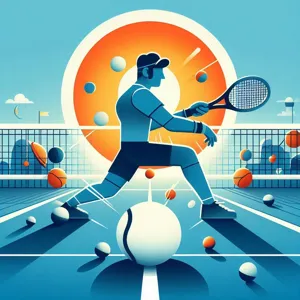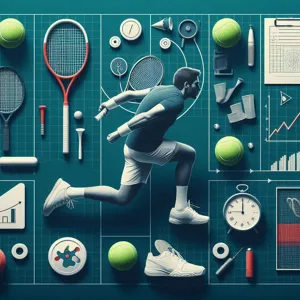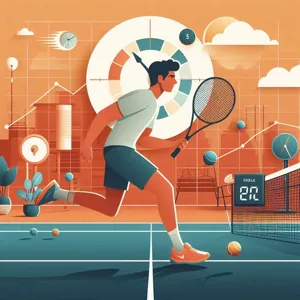Tennis is not just a game of agility and strength; it’s a mental and strategic battle that requires dedication, focus, and a clear vision for improvement.
Whether you’re a budding player eager to refine your serve or an experienced athlete looking to build on your strengths, setting meaningful goals is the key to unlocking your full potential on the court. In this blog post, we will delve into the art of goal-setting tailored for tennis enthusiasts. You’ll discover how to identify specific areas for growth, create actionable plans, and stay motivated throughout your journey. With the right mindset and strategies in place, you’ll not only enhance your skills but also elevate your overall performance, making every match a stepping stone toward greatness. Get ready to ace your game and take your tennis skills to new heights!
1. Understanding the Importance of Goal Setting in Tennis

In the world of tennis, where precision, strategy, and mental fortitude collide, setting clear and achievable goals is not just a beneficial practice—it’s essential for growth and improvement. Understanding the importance of goal setting in tennis can transform your game from good to great. When you step onto the court, you’re not just playing against an opponent; you’re also competing against yourself. Each session presents an opportunity to hone your skills, elevate your performance, and push past your limits, but without a defined direction, it’s easy to drift aimlessly.
Goals in tennis serve as your roadmap, guiding your training and helping you focus on specific areas for improvement. Whether you aim to enhance your serve speed, improve your footwork, or increase your match endurance, having concrete goals allows you to measure your progress systematically. It’s important to set both short-term and long-term goals. Short-term goals can keep you motivated through daily practices, like perfecting your backhand or increasing your consistency during rallies. In contrast, long-term goals can help you visualize your overall aspirations, such as competing in local tournaments or achieving a certain ranking.
Moreover, goal setting instills a sense of accountability and discipline. When you articulate your objectives, you create a commitment to yourself, encouraging you to put in the necessary work even on days when motivation wanes. This accountability can be further amplified by sharing your goals with a coach or a practice partner, who can provide support and constructive feedback along the way.
Remember, the key to effective goal setting lies in making them SMART—Specific, Measurable, Achievable, Relevant, and Time-Bound. For instance, instead of saying, “I want to be better at tennis,” you might set a goal like, “I will improve my first serve percentage to 60% in six weeks.” This clarity not only helps you stay focused but also provides a tangible way to track your progress.
In tennis, where every match can hinge on the smallest margins, understanding the importance of goal setting is your first step towards a more disciplined, purposeful, and ultimately rewarding practice. Embrace this strategy, and watch as your skills elevate to new heights on the court.
2. Types of Goals: Short-term vs. Long-term
When it comes to elevating your tennis skills, understanding the difference between short-term and long-term goals is crucial for creating a structured and effective training regimen.
**Short-term goals** are your immediate stepping stones, typically set for days or weeks, designed to keep you motivated and focused. These could range from mastering a specific technique, like perfecting your backhand slice, to achieving a certain number of successful serves during practice. For instance, you might aim to improve your footwork by dedicating a portion of your practice sessions each week to drills that enhance your speed and agility on the court. Short-term goals allow you to track your progress in real-time, celebrating small victories that build confidence and momentum.
On the other hand, **long-term goals** represent your broader aspirations and are often set for months or even years. These goals provide a larger context for your training efforts. For instance, you might aspire to reach a specific ranking in your local tennis league or train for a major tournament. Long-term goals require careful planning and consistent effort; they encourage you to develop a comprehensive approach to skill development, fitness, and mental resilience. Establishing a long-term goal, like participating in a state-wide competition, can help guide your short-term goals, ensuring that each training session is purposeful and aligned with your ultimate vision.
In essence, balancing short-term and long-term goals creates a dynamic synergy in your training regimen. While short-term goals keep you engaged and focused on the present, long-term goals provide direction and motivation, ensuring that each effort contributes to your overarching ambitions in the game of tennis. By setting both types of goals, you’ll not only enhance your skills but also cultivate a deeper passion for the sport.
3. Assessing Your Current Skill Level

Before you can set effective goals for your tennis improvement, it’s essential to gain a clear understanding of your current skill level. This self-assessment acts as the foundation upon which you’ll build your training regimen and future achievements. Start by evaluating your strengths and weaknesses on the court. Are you confident with your forehand but struggle with your serve? Do you excel in rallies but find it difficult to play at the net? Taking inventory of your abilities will help you pinpoint specific areas for growth.
Consider recording your performance during practice matches or using video analysis to capture your strokes and footwork in action. Watching yourself play can be both revealing and enlightening—friends or coaches can also offer valuable feedback on your technique and strategy. Additionally, take note of key statistics, such as your first serve percentage, unforced errors, and break point conversion rates. These metrics will provide concrete data to gauge your progress over time.
Lastly, don’t shy away from seeking an objective assessment from a coach. A professional can offer insights that you might overlook and help you set realistic, achievable goals tailored to your unique playing style. By accurately assessing your current skill level, you’ll establish a solid baseline from which to launch your journey of improvement, ensuring that the goals you set are both challenging and attainable. This self-awareness not only enhances your training focus but also boosts your confidence as you strive to elevate your game.
4. Defining SMART Goals for Tennis Improvement
When it comes to honing your tennis skills, simply wishing for improvement isn’t enough; you need a structured approach. This is where defining SMART goals can significantly elevate your game. The SMART framework—Specific, Measurable, Achievable, Relevant, and Time-bound—provides a clear roadmap that transforms your aspirations into actionable objectives.
**Specific**: Start by pinpointing exactly what aspect of your game you want to improve. Instead of a vague goal like “I want to be better at tennis,” make it specific: “I want to increase my first serve percentage.” By clearly defining what you wish to achieve, you create a focused target that makes it easier to devise a plan.
**Measurable**: To track your progress, your goal needs to be measurable. Continuing with the first serve example, you could aim to improve your serve percentage from 50% to 65%. This quantifiable metric allows you to assess your advancement and stay motivated as you witness tangible results.
**Achievable**: While it’s important to challenge yourself, your goals should also be realistic. Consider your current skill level, practice time, and physical condition when setting your goals. If you’re currently serving at 50%, aiming for a 90% first serve percentage in a month might be unrealistic. Instead, set a goal to achieve 60% in three months, which pushes you but remains attainable.
**Relevant**: Ensure your goals align with your overall aspirations in tennis. If your ultimate aim is to compete in local tournaments, improving your serve is indeed relevant, as it is a critical component of your game. Every goal you set should serve a purpose that contributes to your broader ambitions on the court.
**Time-bound**: Lastly, set a clear timeline for your goals. This creates a sense of urgency and helps maintain your focus. For example, you might establish that you want to reach your new serve percentage within three months. By specifying a deadline, you’ll be more likely to put in the necessary work to achieve it.
By defining SMART goals, you create a structured framework that not only enhances your training sessions but also keeps you motivated and accountable. Regularly revisit and adjust your goals as you progress, ensuring they continue to challenge you while remaining realistic. With this strategic approach, you’ll find yourself not only improving your tennis skills but also enjoying the journey along the way.
5. Creating a Personalized Training Plan

To truly elevate your tennis skills, creating a personalized training plan is essential. This plan should be tailored to your unique strengths, weaknesses, and specific goals, ensuring that every practice session contributes meaningfully to your development as a player. Start by assessing your current skill level—take note of your serve, forehand, backhand, and overall court strategy. Are there particular shots where you struggle, or do you find yourself outmaneuvered in certain match situations?
Once you’ve identified these areas for improvement, set clear and achievable objectives. For instance, if your serve needs work, your goal might be to increase your first serve percentage by 10% over the next month. Break these larger goals into smaller, manageable milestones to track your progress effectively.
Next, structure your training sessions around these objectives. Incorporate drills that target specific skills, such as serving accuracy, footwork, or net play. A typical session might start with a warm-up, followed by focused drills—like practicing your volleys with a partner or working on your backhand against a wall. Don’t forget to include match-play scenarios to apply what you’ve learned in a competitive context.
Additionally, consider cross-training to enhance your overall athleticism. Activities such as strength training, agility drills, and even yoga can complement your on-court training by improving your physical conditioning, flexibility, and mental focus.
Finally, maintain a training log to record your sessions, reflect on your progress, and adjust your plan as necessary. By creating a personalized training plan that aligns with your tennis aspirations, you’ll not only maximize your practice time but also foster a deeper connection to the game, keeping your motivation high and your skills sharp.
6. Incorporating Match Play into Your Goals
Incorporating match play into your goals is crucial for turning practice into performance. While drilling serves, practicing volleys, and honing your footwork are all essential components of skill development, nothing substitutes the intensity and unpredictability of actual match play. Setting specific match play goals can enhance your understanding of the game, improve your tactical awareness, and build mental resilience.
Begin by scheduling regular match play sessions, whether it’s friendly games with peers, competitive leagues, or practice matches with more experienced players. Set clear objectives for each match, such as focusing on a specific strategy, improving your mental toughness, or applying a particular technique you’ve been working on. For instance, you might aim to incorporate a new serve style under pressure or to maintain composure after losing a point.
Additionally, consider tracking your performance in these matches. Keep a journal or use apps designed for tennis players to analyze your statistics—such as first serve percentage, unforced errors, or points won on break points. This data will not only highlight areas for improvement but also provide you with tangible evidence of your progress, which can be incredibly motivating.
Moreover, use match play as an opportunity to set goals that extend beyond your technical skills. Focus on developing your mental game by setting targets for how you manage stress and maintain focus during crucial points. Challenge yourself to stay positive, communicate effectively with your partner (if applicable), and maintain a competitive spirit, regardless of the score.
By incorporating match play into your goal-setting, you create a dynamic environment that mirrors real-game situations, enabling you to refine your skills and elevate your performance on the court. Embrace the challenge, learn from each experience, and watch as your tennis skills soar to new heights!
7. The Role of Mental Toughness in Achieving Goals

Mental toughness is often the unsung hero in the world of sports, and when it comes to tennis, it can be the defining factor that separates the champions from the challengers. Unlike many other sports, tennis is played in solitude; the pressures of the game rest solely on the player’s shoulders. This unique aspect demands a robust mental fortitude to navigate the highs and lows of competition.
To elevate your tennis skills and truly ace your game, cultivating mental toughness is essential. It involves developing resilience, focus, and a positive mindset, all of which are crucial when facing setbacks or challenging opponents. Picture yourself in a tense match, the score tied, the crowd buzzing with anticipation. In such moments, it’s not just your physical skills that will carry you through, but your ability to maintain composure, stick to your game plan, and execute under pressure.
Setting specific, achievable goals is a vital first step in this process. These could range from enhancing your serve accuracy to improving your footwork. However, simply setting the goals isn’t enough; you must also foster a mental approach that embraces challenges and views failures as opportunities for growth. Incorporating visualization techniques can be particularly effective. Spend time imagining yourself performing at your best, executing each shot with precision and confidence. This practice not only prepares you mentally but also reinforces a winning attitude.
Additionally, consider the power of mindfulness and self-talk. Being present in the moment during practice and matches can help reduce anxiety and improve focus. Replace negative thoughts with positive affirmations to build confidence and reinforce your belief in your abilities. For instance, remind yourself, “I am capable of playing my best game” or “Each point is a new opportunity.”
Ultimately, mental toughness is not just about grit; it’s about nurturing a balanced mindset that allows you to thrive under pressure. By prioritizing mental strength alongside your physical training, you’ll find that achieving your tennis goals becomes not only possible but also deeply rewarding. Embrace the mental aspect of the game, and watch as your skills and performance soar to new heights.
8. Tracking Your Progress: Tools and Techniques
Tracking your progress is a critical component of elevating your tennis skills, providing you with valuable insights into your performance and helping you stay motivated. In the age of technology, there are numerous tools and techniques available that can assist you in monitoring your development on the court.
One effective method is using mobile apps designed specifically for tennis players. Apps like TennisTracker and SwingVision allow you to log match statistics, analyze shot placement, and even receive personalized feedback based on video analysis. These platforms enable you to track your serves, volleys, and baseline play, giving you a comprehensive overview of your strengths and areas for improvement.
In addition to digital tools, keeping a training journal can be incredibly beneficial. Document your practice sessions, noting drills you performed, physical condition, and mental state. This simple yet powerful technique not only serves as a record of your journey but also helps you identify patterns over time, such as how certain drills correlate with improved on-court performance.
Using a physical training log, you can set specific goals for each session—whether it’s improving your first serve percentage or increasing your rally consistency. Regularly reviewing your entries allows you to adjust your training regimen based on what works best, ensuring that each practice session is purposeful and directed towards your overarching goals.
Lastly, consider leveraging wearable technology, such as fitness trackers or smartwatches, that can monitor your heart rate, calorie burn, and even the intensity of your matches. These metrics can provide insight into your fitness level and help you gauge whether you’re pushing yourself sufficiently during training.
By combining these tools and techniques, you create a robust system for tracking your progress. Celebrate your milestones, no matter how small, and reflect on your growth. With a clear understanding of where you started and the distance you’ve traveled, you’ll not only elevate your skills but also cultivate a deeper love for the game.
9. Overcoming Setbacks and Staying Motivated
In the world of tennis, setbacks are as common as double faults. Whether it’s a disappointing performance in a crucial match, an injury that sidelines you for weeks, or a plateau in your skill development, facing adversity is part of the journey. However, how you respond to these challenges can be the defining factor in your growth as a player.
First and foremost, it’s essential to embrace setbacks as learning opportunities rather than insurmountable obstacles. Analyze what went wrong during a match or practice session—was it technique, strategy, or perhaps mental focus? By identifying specific areas for improvement, you can create actionable steps to work on them in your next training sessions. Remember, even the greatest athletes have experienced losses; it’s their resilience and adaptability that set them apart.
Staying motivated through tough times can be a challenge, but it’s crucial for your long-term development. Set small, achievable goals that lead up to your larger objectives. Instead of fixating solely on winning a tournament, focus on mastering a particular stroke or improving your footwork. Celebrate these smaller victories, as they will fuel your passion and remind you of the progress you are making.
Surrounding yourself with a supportive community can also make a significant difference. Engage with fellow players, coaches, and friends who uplift you and share your love for the game. Their encouragement can provide a much-needed boost during challenging times. Don’t hesitate to share your struggles; you might find that others have faced similar issues and can offer valuable advice or simply lend a listening ear.
Lastly, keep the joy of tennis at the forefront of your mind. Revisit what drew you to the sport in the first place—whether it was the thrill of hitting a perfect serve, the camaraderie of playing doubles, or the beauty of the game itself. Allowing yourself to enjoy the process will help you maintain your motivation, even when the going gets tough. Remember, every setback is just a setup for a comeback, and with the right mindset, you can elevate your skills and emerge stronger than ever.
10. Seeking Feedback from Coaches and Peers
Seeking feedback from coaches and peers is a crucial component of any athlete’s growth, particularly in a nuanced sport like tennis. While self-assessment is valuable, the insights of others can illuminate areas for improvement that you may not recognize on your own. Coaches, with their trained eyes, can pinpoint technical flaws in your serve or forehand, offer strategic advice for match play, and help you refine your overall game plan. Their experience not only provides you with a clearer roadmap to your goals but also motivates you to push beyond your perceived limits.
Equally important is the feedback from your peers—fellow players who understand the nuances of the game and can offer relatable perspectives. Engaging in practice matches or friendly drills with them allows for a collaborative learning environment where you can share tips and techniques. This peer interaction can foster a supportive atmosphere that encourages open discussions about strengths and weaknesses, making the learning process more enjoyable and effective.
Consider setting up regular check-ins with your coach to discuss your progress towards your goals. These sessions can serve as a dedicated time to review your performances, assess your skill development, and recalibrate your objectives based on constructive feedback. Additionally, take advantage of video analysis. Recording your matches or practice sessions and reviewing them together with your coach can provide invaluable insights that are often missed in real-time play.
Ultimately, embracing feedback is about creating a cycle of continuous improvement. By actively seeking out the perspectives of those around you, you’ll not only enhance your technical skills but also build a stronger mental game, setting you on the path to elevate your tennis performance to new heights.
11. The Importance of Physical Conditioning
When it comes to elevating your tennis skills, physical conditioning is not just an advantage; it’s a necessity. Tennis is a demanding sport that requires a unique blend of agility, strength, endurance, and flexibility. Each match can be a grueling test of stamina, where players engage in rapid movements, explosive sprints, and intricate footwork. Therefore, investing time in physical conditioning will not only enhance your performance on the court but also reduce the risk of injury.
To effectively boost your physical conditioning, start by incorporating a well-rounded fitness regimen into your training routine. Focus on cardiovascular exercises like running, cycling, or swimming to build the endurance needed for long matches. Pair this with strength training to develop the muscle power essential for serving and volleying. Exercises targeting the core, legs, and upper body will improve your stability and shot precision.
Don’t overlook the importance of flexibility either. Stretching and yoga can significantly enhance your range of motion, allowing you to reach those hard-to-get balls while maintaining balance. Moreover, agility drills—such as ladder workouts or cone drills—can sharpen your reflexes and foot speed, enabling you to move quickly and efficiently across the court.
Remember, conditioning is not a one-time effort but a continuous process. Regular assessments of your fitness levels will help you identify areas that need more attention. By prioritizing your physical conditioning, you’ll find yourself not only playing better but also enjoying the game more, with the stamina to outlast your opponents and the strength to unleash powerful shots that can turn the tide of a match. So lace up those sneakers, hit the gym, and prepare to take your tennis game to new heights!
12. Developing a Stronger Tennis Mindset
Developing a Stronger Tennis Mindset
In the world of tennis, physical prowess is only one piece of the puzzle; mental fortitude is equally, if not more, crucial to your success on the court. Cultivating a strong tennis mindset can transform your game, allowing you to tackle challenges with resilience and focus. This involves not only refining your technical skills but also nurturing your mental approach to the sport.
Start by setting clear, achievable goals that give your practice sessions direction. Rather than vague aspirations like “becoming a better player,” focus on specific objectives such as improving your serve accuracy or mastering a new shot. Break these goals down into smaller milestones that you can celebrate along the way. This will keep you motivated and provide a sense of accomplishment, reinforcing a positive mindset.
Visualization is another powerful tool in developing your mental game. Picture yourself executing your shots with precision, winning points, and overcoming obstacles. This mental rehearsal can enhance your confidence and help you approach matches with a winning attitude. Coupled with mindfulness practices, such as meditation or deep-breathing exercises, you can learn to stay present during high-pressure moments, reducing anxiety and improving performance.
Moreover, learn to embrace failures as part of your growth. Every missed shot or lost match is an opportunity for reflection and improvement. Analyze what went wrong, adjust your strategy, and approach your next game with renewed determination. This growth mindset fosters resilience, enabling you to bounce back stronger and more focused than before.
Lastly, surrounding yourself with a supportive tennis community can significantly impact your mindset. Engage with fellow players, coaches, and mentors who inspire and challenge you. Their encouragement and constructive feedback can boost your confidence and help you maintain a positive outlook, even in the face of adversity.
By developing a stronger tennis mindset, you’ll not only enhance your skill set but also your enjoyment of the game. Remember, tennis is as much about mental strength as it is about physical ability. Embrace the journey, stay committed to your goals, and watch as your game elevates to new heights.
13. Celebrating Milestones and Successes
Celebrating milestones and successes is an essential part of your tennis journey that should never be overlooked. Each accomplishment, no matter how small, serves as a stepping stone towards your larger goals and warrants recognition. Whether it’s mastering a new serve, winning a local tournament, or simply improving your consistency on the court, taking the time to acknowledge these achievements can significantly boost your motivation and confidence.
When you celebrate your successes, you reinforce positive behaviors and cultivate a growth mindset. Consider creating a personal reward system for your achievements—perhaps treating yourself to a new piece of tennis gear or enjoying a special outing with friends after reaching a specific goal. This not only adds excitement to your training but also creates memorable associations with your hard work.
Moreover, sharing your milestones with your support network can amplify the joy of your accomplishments. Whether it’s posting on social media, discussing your progress with your coach, or celebrating with fellow players, these shared moments foster a sense of community and support, making your tennis journey feel more rewarding.
Remember, every great player has reached milestones on their path to success. By celebrating your own achievements—big or small—you not only honor your dedication and effort but also ignite a passion that will propel you toward higher levels of play. So, don’t wait for the grand victories; take the time to pause, reflect, and celebrate your milestones as you ace your game on the court!
14. Adjusting Goals as You Progress
As you embark on your journey to elevate your tennis skills, it’s crucial to recognize that goal-setting is not a one-and-done task. Just as your game evolves with each match and practice session, so too should your goals. Adjusting your objectives allows you to stay motivated, focused, and aligned with your growing abilities.
Begin by regularly assessing your performance. After a tournament or a series of practice matches, take time to reflect on what you’ve learned. Did you struggle with your serve? Perhaps your goal should shift to mastering different serves or improving your serve placement. If you’re consistently winning matches, consider setting a more challenging target, such as competing in a higher-level tournament or working on advanced footwork techniques.
Flexibility is key. Your initial goals might have been about improving your backhand, but as you progress, you may find that your forehand is now your weaker shot. Embrace this evolution and adjust your goals accordingly. It’s also important to celebrate milestones along the way, no matter how small. Achieving a goal—like consistently hitting your target in practice—can boost your confidence and inspire you to aim higher.
Remember, the ultimate aim is to foster a deep love for the game and a desire to constantly improve. By regularly reassessing and adjusting your goals, you’ll not only enhance your skills but also cultivate resilience and a growth mindset. This dynamic approach ensures that your training remains fresh and engaging, keeping you excited for every practice session and match that lies ahead.
15. Conclusion: The Journey to Becoming a Better Tennis Player
As we wrap up this exploration of goal-setting in tennis, it’s important to remember that the journey to becoming a better player is a continuous one. Each step you take, whether it’s refining your serve, mastering your footwork, or improving your mental game, contributes to your growth on and off the court. Setting clear, achievable goals not only provides direction but also fuels your motivation and passion for the sport.
Embrace the process. Understand that progress may come in small increments, and celebrate those victories, no matter how minor they may seem. Each practice session, match, and point is an opportunity to learn and improve. Surround yourself with a supportive community—coaches, teammates, and fellow players can help keep you accountable and inspired.
As you embark on this journey, remember that resilience is key. There will be challenges and setbacks, but these moments are often the most valuable learning experiences. Stay committed to your goals, adapt your strategies as needed, and maintain a positive mindset.
Ultimately, the path to becoming a better tennis player is not just about achieving milestones; it’s about cultivating a love for the game and enjoying the ride. So grab your racquet, hit the court, and let your aspirations propel you forward. Your best tennis is yet to come!
As we wrap up our exploration of setting goals to elevate your tennis skills, remember that success on the court is a journey defined by persistence, determination, and a clear vision. By implementing the strategies outlined in this post, you can transform your aspirations into actionable steps that lead to tangible improvement. Whether you’re refining your serve, mastering your footwork, or building mental resilience, each goal you set brings you closer to becoming the player you aspire to be. So, grab your racket, hit the court with renewed purpose, and embrace the process of growth. Your tennis journey is just beginning, and with the right mindset and targeted goals, the sky is the limit. Happy playing!






